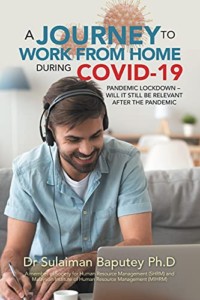Title: A Journey to Work from Home During COVID-19 Pandemic Lockdown. Will it Still Be Relevant after the Pandemic?
Author: Dr. Sulaiman Baputey, Ph.D.
Publisher: PartridgePublishing
ISBN: 978-1-5437-6414-7
Genre: Non-fiction
Pages: 114
Reviewed by: Susan Brown
Pacific Book Review
A worldwide lockdown in 2020, due to the COVID-19 pandemic, shut down businesses and sent people home to work. The lockdown lasted more than a year, with businesses incrementally coming back on line in 2021 and employees hesitantly returning to workplaces; but the employee workplace had changed dramatically, if not irreversibly. This book takes a look at that change to better understand the post-COVID-19 workplace culture and to get a picture of what a “new normal” for employees might look like.
In the beginning of the book the author details the shift triggered by the pandemic from office to home workplace, as well as the challenges faced by both employers and employees in this new paradigm. Subsequent chapters include information specific to the virus: the first coronavirus discovery in the 1930, how the virus infects humans, where COVID-19 originated, treatment and isolation best practices and the current outbreak’s trajectory around the world.
The author devotes an entire chapter to the impact of COVID-19 on a person’s physical health, psyche and mental health. He writes, “… the COVID-19 pandemic has greatly reduced social contacts with a consequent increase of mental suffering challenges and psychologically-related diseases.” He identifies what these physical and psychological challenges are with an eye toward helping those suffering understand the cause/effect relationship to COVID-19.
The crux of this book, though, is a deep dive into navigating the work-from-home scenario for both employers and employees. Working from home is not a new concept, but “coupled with digital technological advancement in personal computer, the Internet, email, broadband connectivity, laptops, smartphone, cloud computing, teleconferencing, Zoom, Google Meet, and recently, artificial intelligence and robotics, it has become accessible to a broader spectrum of employees.” This in turn creates challenges for human resource professionals. Fortunately, the author provides some very sensible and pragmatic solutions, including what should be covered in policy and procedures guidelines.
Dr. Baputey does indeed take the reader on a journey to understand just how the COVID-19 outbreak has “reshaped the future landscape of works.” His viewpoints are well-supported by data and factual information on everything from the etymology of the coronavirus to the economic impact of this infectious disease on the industries around the world to how businesses and employees can thrive post pandemic.
Although the writing is academic in tone, the subject matter is so timely and germane that it’s easy to read this book in one sitting, and is valuable even for those who are not currently balancing work from home challenges. I took a great measure of comfort from this book. Understanding is, for me, the key to action. The effects of the pandemic reshaped our lives, but Dr. Baputey has given us a guide on how to proactively negotiate these changes.


